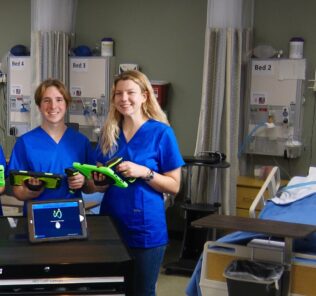Virtual Simulation Helps Prepare Nursing Students for NextGen NCLEX
Virtual simulation is not a new concept. However, during the onset of the COVID-19 pandemic in 2020, nursing schools were forced to either close their doors or offer a fully online curriculum. During this time, classroom learning segued more easily to the virtual world than the skills lab and healthcare simulation did. This was a result of virtual simulation, an immersive, interactive clinical simulation through which learners interact with a patient through the computer mouse or keyboard. This HealthySimulation.com article shares more about the goal of virtual simulation, and how the technology can work to reproduce and recreate reality in preparation for the Next Gen NCLEX.
Today, NextGen prep recommends nursing schools engage in active learning activities. What better way to accomplish this then than through virtual simulation? As with all types of healthcare simulation, virtual simulation focuses on learning rather than teaching. The facilitator steps back to allow the learners to explore the clinical simulation scenario and to self-determine appropriate nursing action without interrupting the flow.
Virtual simulation gives learners an opportunity to engage in all learning environments (visual, auditory, and psychomotor). A high-quality virtual simulation addresses the multigenerational/multicultural needs of diverse learners and patients since scenarios can be designed to target these groups. Virtual simulation can be adapted for individual, paired, or group learning.
Sponsored Content:
Further, the nature of healthcare simulation allows the learner to practice skills and competencies, which must be evaluated over time and by different faculty. Virtual simulation thereby provides learners with the opportunity to practice their skills and to integrate knowledge and attitudes to develop a higher level of critical thinking.
High-quality virtual simulation also encourages the use of cognitive skills and develops clinical judgment. Repeating the scenarios help learners to gain confidence in order to provide safe, patient-focused care in a live setting. Virtual simulation is an ideal companion to didactic learning. Thus, virtual simulation prepares learners for the NextGen NCLEX by strengthening the emphasis on clinical judgment.
More About Virtual Simulation NCLEX Exam Preparation
The NextGen NCLEX exam focuses on the clinical judgment through the use of phased clinical situations. What does this mean? The NextGen exam uses an adaptive format with fewer test items. The learner is presented with three unfolding clinical situations. Each of these requires the learner to answer six test items that evaluate clinical judgment during patient care. Information is presented in a medical record format (history and physical, nurse notes, orders, and lab results).
Sponsored Content:
Spring 2023 is the launch date for the NextGen NCLEX licensing exam. Leading up to this, the National Council of State Boards of Nursing (NCSBN) reviewed the current nursing practice and found major changes have evolved in nursing practice:
- There is an increased complexity of patient care.
- New scientific developments to prolong life require new proficiencies.
- Protecting patients involves the use and understanding of new technologies.
- Patients seek care more often outside of a hospital. They receive healthcare at home, or in long-term care facilities.
A survey of the nation’s hospitals found that new nurses are not adequately prepared for practice. The survey showed that:
- 50% of novice nurses are involved in practice errors.
- 65% of these errors are in clinical judgment.
- Many employers are not satisfied with a new grad’s ability for safe, clinical judgment.
Currently, clinical practice sites are in heavy demand on a national level. Medical, nursing, and allied health learners jostle for placement in hospitals and other healthcare facilities to practice their skills in a live patient setting. Recently, a landmark study by the NCSBN concluded that high-quality simulation had similar learning outcomes when substituted for up to 50% of on-site clinical learning.
The keywords here are “high-quality simulation.” A high-quality simulation scenario needs to provide learners with the opportunity to improve clinical judgment. NextGen updates on clinical judgment focus on:
- Recognizing cues – What matters most?
- Analyzing cues – What could it mean?
- Prioritizing a hypothesis – Where do you start?
- Generating solutions – What can be done?
- Taking action – What will you actually do?
- Evaluating the outcomes – Did the scenario help?
High-quality simulation, provided by a carefully constructed scenario, can address each of these six points. This is because high-fidelity simulation demands the learner recognize important cues and analyze their significance. Learners must prioritize their care of the simulated patient. Individually, or in a group, learners determine what can and will be done to treat the main problem. As such, debriefing is where learners evaluate whether or not outcomes were achieved under the guidance of faculty.
Similar to clinical learning in a hospital setting, sim helps learners develop cognitive, psychomotor, and affective learning. Through healthcare simulation, learners have an opportunity to care for diverse patient populations. Healthcare simulation also helps learners to improve their care and gain the skills needed to become part of an interprofessional team as graduate nurses.
When virtual simulation was tested across cognitive and affective domains, the findings were in line with live patient care experience. Positive outcomes were confirmed as learners reported gains in knowledge and improved levels of learning. Additionally, cognitive development was enhanced, along with refined practical nursing skills.
Learners reported virtual simulation was fun and they felt engaged. They appreciated the level of realism virtual simulation provided. In general, learners found the software easy to use. They were also able to utilize recent developments in the field of virtual simulation, including the use of virtual reality (VR) or augmented reality (AR). VR employs special 3D near-eye displays to immerse the learner into a virtual world, whereas AR combines real-world and computer-generated content. As with all technology, there are pros and cons to both types of virtual sim.
Pros of Virtual Simulation include:
- Reflects real-world situations through interaction with an avatar.
- Presents patients’ clinical situation through a scenario.
- Enables repetitive learning (essential for achieving competency in a skill).
- Flexibility and accessibility for long-distance learning (Learners can access the virtual simulation through any computer in any location).
Cons of Virtual Simulation include:
- Learners must have access to a computer (if not in school for the sim).
- The cost of purchasing software may prevent schools from being able to offer virtual simulation.
- Virtual simulation requires learner and faculty training in order to navigate the scenario.
Pros of VR/AR include:
- A 3D image or environment enhances the feel of realism.
- Special equipment allows for interactive learning.
- This type of virtual simulation encourages a high level of learner engagement.
Cons of VR/AR include:
- The potential for injury while wearing goggles (the wearer can’t see their surroundings).
- Software limitations (Additional purchases are required to enhance scenario libraries).
- VR/AR relies on paired technology.
- Learners may not be able to suspend disbelief.
More About the NCLEX-EN
The National Council of State Boards of Nursing (NCSBN) has developed a licensure examination, the National Council Licensure Examination for Registered Nurses (NCLEX-RN), which is used by member board jurisdictions and most Canadian nursing regulatory bodies, to assist in making licensure decisions. The test plan is reviewed and approved by the NCLEX Examination Committee every three years. Multiple resources are used, including the recent practice analysis of registered nurses (RNs), and expert opinions of the NCLEX Examination Committee (NEC), NCSBN content staff, and boards of nursing/regulatory bodies to ensure that the test plan is consistent with nurse practice acts.
Downloadable NCLEX Test Plan Checklists for Nursing Simulation
Resources
American Association of Colleges of Nursing (2021) The essentials: Core competencies for professional nursing education. https://www.aacnnursing.org/Portals/42/AcademicNursing/pdf/Essentials-2021.pdf
Ignatavicius, D. and Silvestri, L. (2021) Preparing for the Next-Generation NCLEX (NGN). https://evolve.elsevier.com/education/wp-content/uploads/sites/2/NGN_FacultyGuide_Final.pdf
Kathy Sokol lived most of her adult life in Florida before “retiring” to Las Vegas. She has been a registered nurse for over 30 years and a nurse educator since 2005. Kathy has a masters degree in nursing education and earned Master Instruction certification from Chamberlain University College of Nursing.
She set up and managed simulation labs on several campuses throughout the country. Kathy collaborated on a course called Sim 101 to educate faculty on how to enrich student learning through simulation. In 2016, Kathy and her team did a presentation at IMSH on how to efficiently open a sim lab while saving time and money.
Kathy was initiated into Sigma Theta Tau International Honor Society. She was a nominee for the Daisy Faculty Nurse Award. She has been published in RN Magazine, is a regular contributor on LinkedIn and has an adult learning page on Facebook. She is currently working on a book about change.
Kathy lives in Las Vegas with her husband. She is a visiting professor at Chamberlain University College of Nursing.
Sponsored Content:




















